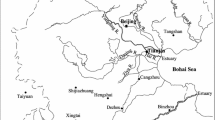Abstract
Flat-lying dolostones of the Devonian Keg River Formation form an escarpment about 30 m high, 30 km west of Fort Smith on the boundary of Alberta and the North West Territories of Canada. The dolostone is underlain by gypsum beds of the Devonian Chinchaga Formation.
Gypsum solution causes numerous collapse dolines in the Keg River Formation. One doline, 45 m in diameter, has 15 m high, vertical walls of dolostone.
We have applied 3 systems, developed to determine the support necessary for underground openings of a given span in a give rock mass, to the assessment of the natural opening beneath the doline.
From the characteristics of the rock mass, a 15 m unsupported span in the formation can be expected to stand-up for about one month.
We suggest that unsupported natural openings exist which are about three times larger than any we would design in the rock mass because:
-
1.
Underground opening design is conservative;
-
2.
Natural sethods of excavation cause less damage to the surrounding rock than artificial excavation methods; and
-
3.
Natural solution channels tend to form with their axes parallel to gaping joints. These gapes tend to close if substantial compressive stresses exist normal to the joints. Thus, the major axes of natural underground openings tend to parallel the largest compressive stresses in the rock mass, an arrangement which enhances the stability of the openings.
Résumé
A 30 km à l'Ouest de Fort Smith, à la frontière entre l'Alberta et les Territoires du Nord-Ouest du Canada, se trouve un escarpment d'environ 30 m de haut formé par des dolomies de la Formation Dévonienne du Keg River en couches horizontales. Ces dolomies se trouvent sur des couches de gypse de la Formation Devonienne du Chinchaga.
Les solutions de gypse produisent de nombreuses dolines d'effondrement dans la Formation du Keg River. Une de ces dolines de 45 m de diametre a des murs de dolomie verticaux de 5 m de haut.
Certains systèmes ont été developpés afin de déterminer les supports nécessaires à des ouvertures d'une portée donnée dans un massif rocheux donné, et nous avons appliqué 3 de ces systèmes à l'évaluation de la stabilité des ouvertures naturelles au-dessous de cette doline.
D'après les caractéristiques du massif roucheux, la largeur maximale d'une portée qui pourrait rester stable pendant un mois est de 15 m.
Nous pensons qu'il existe des ouvertures naturelles dont les portées sont 3 fois plus larges que celles dont nous ferions les plans dans le même massif roucheux, parce que:
-
1.
Les plans des ouvertures souterraines tiennent compte de larges marges de sécurité;
-
2.
Les conditions naturelles de l'excavation causent moins de dégradations dans les roches environnantes que les interventions artificilles; et
-
3.
Les cavernes ayant des axes paralleles aux diaclases ouvertes ont tendance a se former; les diaclases tendent a se refermer si des contraintes de compression substantielles perpendiculaires aux diaclases existent.
Ainsi les axes majeurs des ouvertures naturelles sont en général parallèles aux plus grands contraintes de compression dans le massif rocheux, arrangement qui augmente la stabilité des ouvertures.
Similar content being viewed by others
References
BARTON, N. (1976a): Recent experiences with the Q-system of tunnel support design. Proceedings, Symposium on Exploration for Rock Engineering, Johannesburg, I, 107–117.
BARTON, N. (1976b): Unsupported underground openings. Proceedings, Rock Mechanics Meeting, Stifrelsen Bergteknisk Forskning, Stockholm, 1976, pp. 62–94.
BARTON, N., LIEN, R. and LUNDE, J. (1977): Estimation of support requirements for Underground Excavation. Proceedings, 16th Symposium on Rock Mechanics, Minneapolis, American Society of Civil Engineers, New York, pp. 163–177.
BIENIAWSKI, Z. T. (1973): Engineering classification of jointed rock masses. Transactions South African Institute of Civil Engineers, 15, 335–344.
BIENIAWSKI, Z. T. (1974): Geomechanics classification of rock masses and its application to tunneling. Proceedings, 3rd Congress International Society for Rock Mechanics, Vol. IIA, 27–32.
BIENIAWSKI, Z. T. (1976): Rock mass classification in rock engineering. Proceedings Symposium on Exploration for Rock Engineering, Johannesburg, I, 97–106.
LEUNG, Y. W. (1981): Ground Subsidence in Wood Buffalo National Park. M. Eng. Report, University of Alberta, Department of Civil Engineering, 52 pp.
McCUSKER, T. G. (1980): A review of empirical approaches to tunnel support design. Tunnelling Technology Newsletter, 30, pp. 1–8.
NORRIS, A. W. (1963): Devonian stratigraphy of Northern Alberta and Northwestern Saskatchewan. Geological Survey of Canada, Memoir 313.
PRIEST, S. D. and HUDSON, J. A. (1976): Discontinuity Spacings in Rock. International Journal of Rock Mechanics and Mining Science, 13, 135–148.
Author information
Authors and Affiliations
Rights and permissions
About this article
Cite this article
Cruden, D.M., Leung, Y.W. & Thomson, S. A collapse doline in Wood Buffalo National Park Alberta, Canada. Bulletin of the International Association of Engineering Geology 24, 87–90 (1981). https://doi.org/10.1007/BF02595258
Published:
Issue Date:
DOI: https://doi.org/10.1007/BF02595258




